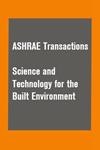多分区住宅室内气候参数的原位实证验证
IF 1.7
4区 工程技术
Q3 CONSTRUCTION & BUILDING TECHNOLOGY
Science and Technology for the Built Environment
Pub Date : 2023-08-09
DOI:10.1080/23744731.2023.2247948
引用次数: 0
摘要
结合建筑室内气候和能源模拟模型直到最近才获得广泛的普及,其应用已经从研究社区转移到更广泛的受众。然而,对新一代复杂多用途动态仿真模型的现场实证验证还比较滞后。本研究使用Modelica中的动态多区域建筑室内气候和能量模拟模型与IDEAS库和浮力驱动的气流组件(通过CONTAM验证),展示了模型验证结果和从荷兰一个有人居住和机械通风的案例研究住宅的常见室内气候参数(即室内空气温度()、相对湿度(RH)和二氧化碳浓度(CO2))的现场经验验证研究中获得的经验教训。仿真结果表明,Modelica中最新一代建筑室内气候与能源模型具有较强的多区住区室内常见气候参数预测能力(前提是提供用户行为信息)。所研究的三个参数的评估指标显示出良好的校准标准(即MAE在0.60-0.78°C (), 3.5-4.6% (RH)和88-181 ppm (CO2)之间),附图证实了研究结果。在没有运动传感器数据可用的情况下,统计生成的占用概况证明了良好的代表性替代方案,条件是可以获得有关居民数量和居民生活方式的基本信息。现场监测经验模型验证证明是一个真正的挑战,充满了(未)预见的障碍。本文章由计算机程序翻译,如有差异,请以英文原文为准。
In-situ empirical validation of common indoor climate parameters in an inhabited multizone dwelling
Combined building indoor climate and energy simulation models only recently gained vast popularity and their application has been moving from the research community to a broader audience. Yet, in-situ empirical validation of this new generation of complex multi-purpose dynamic simulation models has lagged behind. Using a dynamic multizone building indoor climate and energy simulation model in Modelica with the IDEAS library and buoyancy driven airflow components (validated with CONTAM), this research presents model validation results and lessons learned from an in-situ empirical validation study of common indoor climate parameters (i.e., indoor air temperature ( ), relative humidity (RH) and CO2 concentration (CO2)) for an inhabited and mechanically ventilated case study dwelling in The Netherlands. The simulation results show that the latest generation of building indoor climate and energy models in Modelica have great ability to accurately predict common indoor climate parameters in multizone inhabited dwellings (provided that user behavior info is available). Evaluation metrics for the three studied parameters show excellent calibration criteria (i.e., MAE between 0.60–0.78 °C ( ), 3.5–4.6% (RH) and 88–181 ppm (CO2)) and the accompanying graphs corroborate the findings. In the event that no motion sensor data is available, statistically generated occupancy profiles prove good representative alternatives on the condition that basic info is available about the number of inhabitants and the inhabitants’ lifestyle. In-situ monitoring for empirical model validation proves to be a real challenge full of (un)foreseen obstacles.
求助全文
通过发布文献求助,成功后即可免费获取论文全文。
去求助
来源期刊

Science and Technology for the Built Environment
THERMODYNAMICSCONSTRUCTION & BUILDING TECH-CONSTRUCTION & BUILDING TECHNOLOGY
CiteScore
4.30
自引率
5.30%
发文量
78
期刊介绍:
Science and Technology for the Built Environment (formerly HVAC&R Research) is ASHRAE’s archival research publication, offering comprehensive reporting of original research in science and technology related to the stationary and mobile built environment, including indoor environmental quality, thermodynamic and energy system dynamics, materials properties, refrigerants, renewable and traditional energy systems and related processes and concepts, integrated built environmental system design approaches and tools, simulation approaches and algorithms, building enclosure assemblies, and systems for minimizing and regulating space heating and cooling modes. The journal features review articles that critically assess existing literature and point out future research directions.
 求助内容:
求助内容: 应助结果提醒方式:
应助结果提醒方式:


